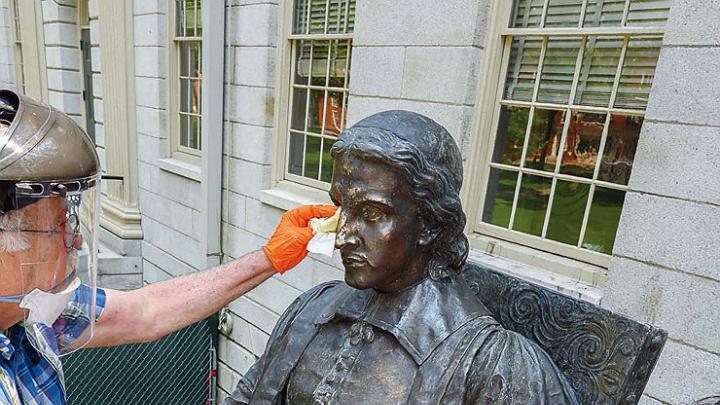The John Harvard statue got a back-to-school makeover just in time for students’ and professors’ long-awaited return to campus. Observant Harvardians and visitors will find the iconic statue spiffed: repatinated in worn areas (patina is the colored surface layer of the metal achieved through chemical alteration) and freshly coated with a protective acrylic lacquer (called Incralac). The base more closely resembles its original presentation now as well, with stains removed from its stone and gilded lettering restored to the inscription on its face. With campus still quiet this July because of COVID-19, the University took advantage of the downtime and partnered with sculpture experts Skylight Studios to perform maintenance, which is routinely scheduled every five to 10 years.
“The cast metal is only a few millimeters thick….It’s really susceptible to corrosion, scratching, and the elements,” says Angela Chang, assistant director, conservation of objects and sculpture, at the Harvard Art Museums and project manager for the statue restoration. After a good cleaning (“with a mild detergent in water, like washing your car and rinsing it thoroughly”), the conservators repatinated faded areas, then applied two coats of Incralac and a thin layer of wax. The Incralac and wax protect the 137-year-old statue from visitor contact and weather damage, and give it a “more saturated” appearance, Chang says—like a painting after it has been varnished.
Passersby will find one structural change in John Harvard’s appearance post restoration: his toe. Worn golden from years of people rubbing it for good luck, his foot is now much darker. Chang is not certain the gold color will be banished completely, but she hopes the conservators can make the patina appear as unified as possible: “It won’t look like the postcard at CVS anymore.” This was a difficult decision for curators in the department of European and American art she says, because “this is a living monument that people interact with every day,” and while Daniel Chester French did not design it with a golden toe, some now believe it’s an integral part of his sculpture. “It’s the only place where the public can really touch the University,” she says. Fans of John Harvard’s foot should not lose hope completely, though. If visitors keep rubbing the toe (the conservator in Chang hopes they won’t), eventually the new patina will wear away, rendering John Harvard’s toe golden once again.







